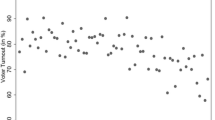Abstract
We consider the degree of ideological polarizationwithin and between the parties in the U.S. House ofRepresentatives for the period 1963–1996, using theGroseclose, Levitt and Snyder (1996) adjustment method for ADA and ACU scores to ensure over timecomparability of roll call voting data. We focusespecially on the median House member, since webelieve that change in the median offers a bettermeasure of the impact of the change in party controlthan does changes in the mean roll-call votingscore.
Our data analysis makes two general points. First andforemost, when we looked at the change in the locationof the House median voter, we found a dramatic changeafter the Republicans gained a majority in the House in1994. After the Republicans became a majority in theHouse, the ADA median in the House in 1995–1996 was at24, far closer to the Republican median of 4 than tothe Democratic median of 83. The shift in medianfrom 1993–1994 to 1994–1995 involved a change of over 25points in one election – far and away the greatestsingle shift in ideology of the modern era. Incontrast, the mean changed only 1 point overthis same period. Second, for the three decades weinvestigated, we found three historical epochs vis a visthe relative locations of the ADA (or ACU) floormedian and the ADA (or ACU) floor mean in the U.S.House of Representatives – two inflection points in1983 and 1994 which are related to trends in regionalrealignment.
Similar content being viewed by others
References
Aldrich, J.H. and Rohde, D.W. (1995). Theories of party in the legislature and the transition to Republican rule in the House. Working Paper 95-05, Program in political institutions and public choice, Institute for Public Policy and Social Research, Michigan State University.
Black, D. (1958). The theory of committees and elections. New York: Cambridge University Press.
Downs, A. (1957). An economic theory of democracy. New York: Harper and Row.
Enelow, J. and Hinich, M.J. (1984). The spatial theory of voting. New York/London: Cambridge University Press.
Enelow, J. and Hinich, M.J. (Eds.) (1990). Advances in the spatial theory of voting. New York/London: Cambridge University Press.
Grofman, B., Griffin, R. and Glazer, A. (1990). Identical geography, different party: A natural experiment on the magnitude of party differences in the U.S. Senate, 1960-84. In R.J. Johnston, F.M. Shelley and P.J. Taylor (Eds.), Developments in electoral geography, 207-217. London: Routledge.
Grofman, B. and Handley, L. (1998). Estimating the impact of voting-rights-act-related districting on democratic strength in the U.S. House of Representatives. In B. Grofman (Ed.), Race and redistricting in the l990s. New York: Agathon Press.
Grofman, B., Merrill, S., Brunell, T. and Koetzle, W. (1999). The potential electoral disadvantages of a catch-all party: Ideological variance among Republicans and Democrats in the 50 states. Party Politics 5: 199-210.
Groseclose, T., Levitt, S.D. and Snyder, J.M. Jr. (1999). Comparing interest group scores across time and chambers: Adjusted ADA scores for the U.S. Congress. American Political Science Review 93: 33-50.
Hinich, M.J. and Munger, M.C. (1994). Ideology and the theory of political choice. Ann Arbor: University of Michigan Press.
Lublin, D.I. (1995). Race, representation and redistricting. In P.E. Peterson (Ed.), Classifying by race. Princeton, NJ: Princeton University Press.
Merrill, S., Grofman, B., Brunell, T. and Koetzle, W. (1999). The power of ideologically concentrated minorities. Journal of Theoretical Politics 11: 57-74.
Miller, N. (1996). Majority rule and minority interests. In I. Shapiro and R. Hardin (Eds.), Political order. New York: New York University Press.
Ornstein, N., Mann, T. and Malbin, M. (1991). Vital statistics on Congress, 1989-1990. Washington, D.C.: American Enterprise Institute.
Poole, K. and Rosenthal, H. (1997). Congress: A political-economic history of roll call voting. New York/London: Oxford University Press.
Author information
Authors and Affiliations
Rights and permissions
About this article
Cite this article
Grofman, B., Koetzle, W., Merrill, S. et al. Changes in the Location of the Median Voter in theU.S. House of Representatives, 1963–1996. Public Choice 106, 221–232 (2001). https://doi.org/10.1023/A:1005250500200
Issue Date:
DOI: https://doi.org/10.1023/A:1005250500200




